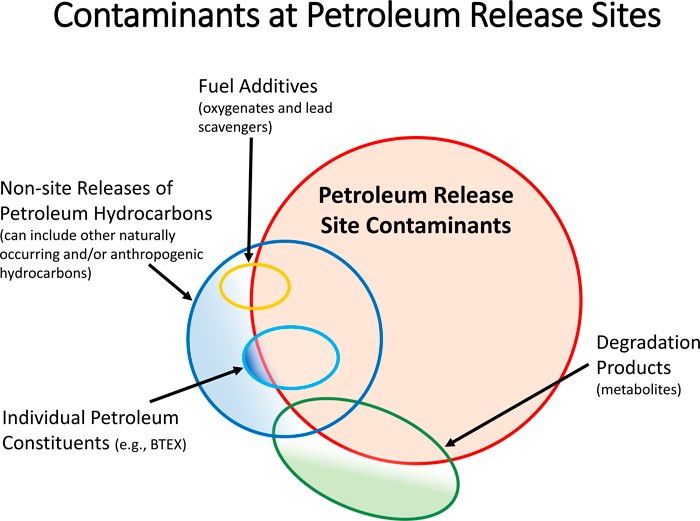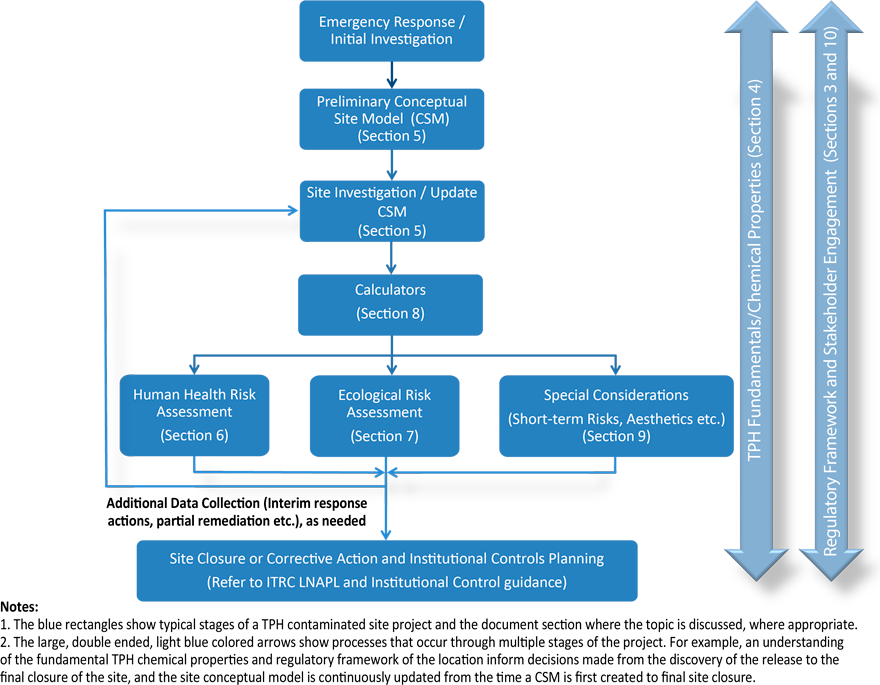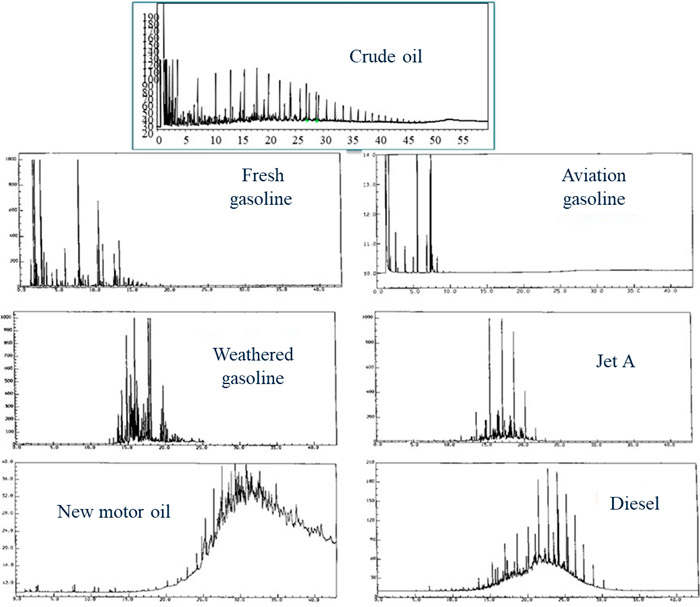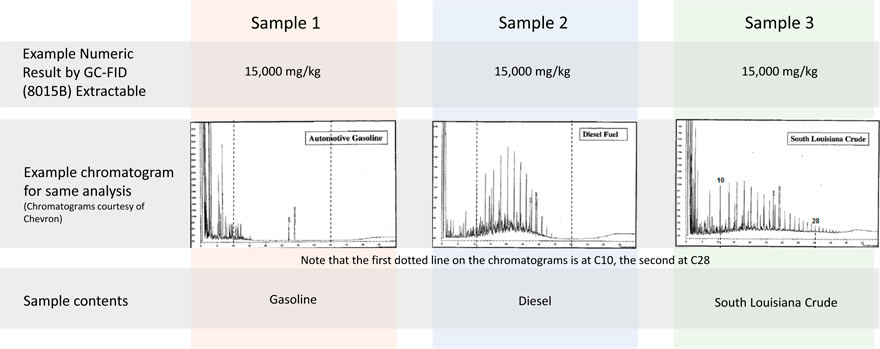2 Introduction
The term “TPH” is often used to refer to the broad range of chemicals comprising petroleum hydrocarbons (see Definition of TPH Fact Sheet). The approaches to assess cumulative risk posed by the multitude of petroleum-related compounds (or mixtures) typically included under the term “TPH” have yet to be widely accepted and employed. Some state programs do not require corrective action based on bulk TPH measurements and use only indicator compounds in their risk assessments while others require a combination of indicator and bulk TPH measurements for decision making.
Risk characterization based on TPH concentration measurements in different environmental media may be used to inform corrective actions or risk management decisions at petroleum release sites. This applies to assessment of potential human health risks as well as ecological risks, which can be challenging because chemical compositions of petroleum hydrocarbon mixtures are complex and subject to change over time due to fate and transport processes (e.g., weathering processes such as biodegradation, dissolution, and volatilization).
TPH screening levels, toxicity value surrogates, and cleanup levels (if any) are inconsistently used across the states. Some states consider the detection of TPH using a variety of methods as evidence of a petroleum release, some use TPH screening level(s), and others do not use TPH analyses at all. The inconsistent approaches stem in part from the uncertain toxicology of TPH ranges, which is due in part to highly variable composition. When published lookup table values are available, they may be misused (e.g., lookup table values used as cleanup levels in cases where it may be more appropriate to consider these values for decision making regarding additional site characterization).
Consistent methodologies and streamlined approaches for establishing risk-based cleanup of TPH-contaminated media are necessary and will assist in the development of evidence-based, technically defensible approaches for risk-based assessments and remediation decision making at petroleum release sites.
2.1 Issues Unique to TPH
Issues unique to TPH are attributed to:
- differing composition of complex mixtures
- different analytical methods (critical because TPH values are method-dependent) and interpretation
- degradation mechanisms and understanding
- varying regulatory approaches
- the presence of petroleum metabolites
As noted, common tiered approaches to risk evaluation, either through the comparison with published screening levels or the development of site-specific screening levels, need to be nuanced and better understood in a TPH risk evaluation. For example, it is common to compare a TPH analytical result to published screening levels; however, the composition of constituents that makes up TPH will vary based on the source of the release and other considerations (see Biodegradation) and may differ from the assumed composition that was used to develop the published screening level. Other approaches (e.g., Tier 3) to quantifying risk may be appropriate for some release sites.
As illustrated in Figure 2-2, petroleum products are complex mixtures. Note that this figure is a conceptual figure to illustrate the different classes of contaminants that may be detected at petroleum release sites and the makeup for specific sites will be different from what is shown in this figure. Contamination at petroleum release sites is likely to consist of a mixture of the original petroleum hydrocarbon compounds (i.e., compounds consisting primarily of carbon and hydrogen atoms, although petroleum mixtures may also contain some other compounds that include nitrogen, sulfur, or oxygen atoms), petroleum-related degradation products (e.g., “metabolites” associated with biologic breakdown of parent compounds), fuel additives (e.g., oxygenates and lead scavengers), and to a limited extent, fuel impurities.
For the purposes of this document, TPH is defined by the aliphatic and aromatic hydrocarbon carbon range fractions covering the applicable carbon range based on the known or assumed original hydrocarbon mixture (or the weathered hydrocarbon mixture thereof), or the hydrocarbon fractions partitioned to water or air. Additionally, TPH analytical results do not distinguish between natural (e.g., crude oil seeps) and anthropogenic sources. A complicating factor for the assessment of risk posed by TPH- and petroleum-related degradation products (which by definition are not “hydrocarbons”) that might be reported under many analytical methods, is the potential presence of similar compounds in soil or water that are unrelated to the petroleum release. Because different combinations of petroleum hydrocarbons can contribute to TPH at different sites, the human health and ecological effects associated with TPH can be dissimilar at different petroleum release sites, even if the TPH concentration is the same.

Figure 2‑2. Conceptual illustration of contaminants at petroleum release sites.
2.2 Applicability of Guidance
This section describes the types of products and sites that are addressed in this guidance. Additionally, human health and ecological risk assessment considerations to be covered are described.
2.2.1 Types of Petroleum Products
This guidance is intended to be applicable for releases of crude oil or refined petroleum products. Refineries produce different suites of petroleum products, with the largest percentage of products being various grades of fuel oil and gasoline. Heavier (less volatile) fractions can also be used to produce asphalt, tar, paraffin wax, and lubricating and other heavy oils. Petroleum products can also be used to describe Stoddard solvent, aviation gas, paint thinner, mineral spirits, bunker oil, jet fuel, kerosene, diesel, motor oil, heating oil, residual fuels, and many refinery intermediates. The various TPH analyses are capable of identifying and quantifying the presence of these products in contaminated media. A more detailed description of petroleum products and potential sources is provided in ITRC 2014 (ITRC PVI Guidance).
2.2.2 Types of Sites
TPH contamination may be detected at sites that store, handle, or use petroleum products at both marine and land releases (see Case Studies). In some instances, neighboring properties impacted by petroleum releases (e.g., downgradient of initial release locations) may have different land uses, such as residential, commercial, or institutional properties, than the release locations. The guidance is applicable for a variety of petroleum sites ranging from smaller sites, such as gas stations with underground or aboveground storage tanks, residential heating oil tanks, or tanker truck spills, to larger petroleum industrial sites, such as bulk storage and distribution terminals, refineries, pipelines, or manufactured gas plants. Additionally, TPH impacts may be identified during property redevelopment, and TPH contamination is often found at historical and active industrial sites. Changes in land use (e.g., redevelopment of commercial or industrial properties for residential land use) also should be considered during site characterization. Lastly, TPH impacts could be encountered from tanker truck or barge fuel releases onto urban and rural areas or through discharges from pipelines that carry crude oil and refined products.
2.3 Background of Current Approaches
Historically, remediation of TPH in soil or groundwater was based on generic screening levels (e.g., 100 mg/kg TPH in soil) or aesthetic considerations (visible presence of oil or odor). In the 1990s, frameworks were developed to characterize TPH risks based on a fraction approach (MADEP 1994; TPHCWG 1998a; WADOE 1997) (see History of TPH Regulation). The fraction approach was used to account for the different chemical, fate and transport, physical, and toxicological properties of different classes of hydrocarbons. Key components of this fraction approach include:
2.4 TPH Risk Characterization Framework
Figure 2-4 illustrates the TPH risk characterization and evaluation framework recommended in this guidance. This framework presents principles and/or concepts for use when characterizing risk posed by surface and subsurface hydrocarbon releases to soil, air, groundwater, or surface water. The site characterization and risk calculation approach described in this document is directed toward characterizing the nature, extent, and risk posed by petroleum-contaminated soil source areas and the vapor phase and dissolved-phase plumes emanating from the contaminated soil source areas.

Figure 2‑4. TPH guidance decision framework.




